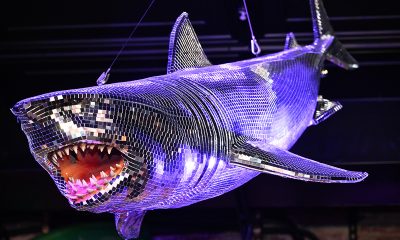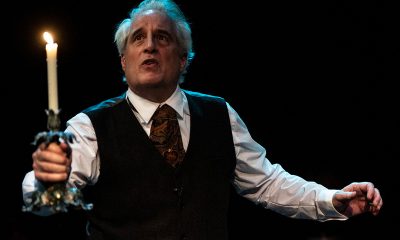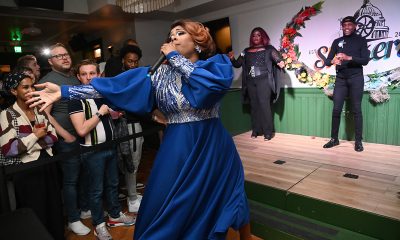a&e features
Webre’s farewell
Long-time Washington Ballet artistic director reflects
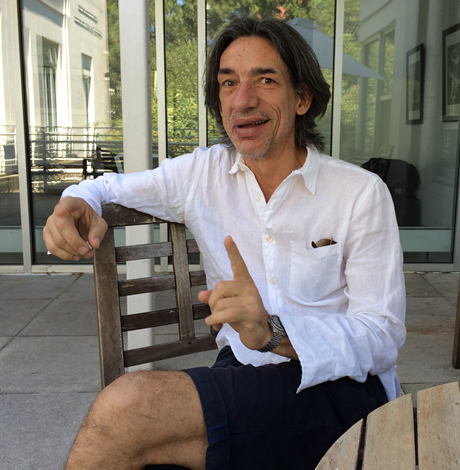

Septime Webre, artistic director of the Washington Ballet since 1999, says he worked to fuse classical ballet elements with contemporary and popular art during his tenure. (Washington Blade photo by Joey DiGuglielmo)
Imagination Stage Presents ‘The Little Mermaid’
In collaboration with the Washington Ballet
Continues through Aug. 14
Lerner Family Theatre
4908 Auburn Ave., Bethesda
Tickets start at $10
imaginationstage.org
Septime Webre didn’t plan on ‘The Little Mermaid,’ an Imagination Stage production produced in collaboration with the Washington Ballet, to be his swan song. It just kind of worked out that way.
But the 54-year-old co-choreographer says everything the Ballet has done this season — he mentions the April “Carmina Burana” performances and the “Bowie & Queen” rock show in May — as being fitting farewells. He wrapped his tenure at the Ballet this week and will join the S&R Foundation, a non-profit started in 2000 by Sachiko Kuno and Ryuji Ueno to support artists and scientists, as its artistic director.
During a Washington Blade interview, Webre — who lives in Adams Morgan with his partner of five years, Marc Cipullo — shared his philosophies, struggles and plans. His comments have been edited for length.
WASHINGTON BLADE: Why are you leaving?
SEPTIME WEBRE: I feel great about my accomplishments here. It’s grown amazingly. But particularly in the last few years, I’ve had a yearning to be in the studio a bit more. Being the director of a company, there are administration duties, PR duties, marketing duties, all that’s involved in overseeing an organization that has grown from a $2 million to a $12 million budget, so I had already been thinking that maybe another chapter would be interesting to really focus on creativity and less institution building for a while. That coincided with a blossoming of my work as a freelance artist in the last few years.
BLADE: Was the managerial aspect stultifying?
WEBRE: No. I’ve enjoyed all that institution building and felt like I wanted to do that while I was still somewhat young and energetic, or at least while my Grindr age was still young. I’m 54 but I skew young. I’m an energetic kind-of guy. So those duties weren’t stultifying, but they certainly got in the way of creating new work. In the last several years, I’ve done full-length ballets based on “The Great Gatsby,” on Hemingway’s “The Sun Also Rises,” last year I did a Washington Irving project and also “Alice in Wonderland.” These works have been much in demand over the last five or six years and I’ve also had some commissions by other companies.
BLADE: I assume the name recognition of these works helps?
WEBRE: That’s part of it but it’s also the return of narrative works in ballet after the era of modernism, which was my generation, and an aesthetic dominated by George Balanchine and Merce Cunningham. These were abstract artists and from the mid-century through the time I was dancing, serious choreographers really didn’t tackle narratives. It was not considered serious. But during my choreographic career, I began to tackle them because in many ways, it’s who I am. There’s something inside of me, this boisterous Cuban family and the brothers on the weekend, all we do is get together and drink cold Mexican beer and tell stories. So I was naturally drawn to these great books and they also happen to sell tickets.
BLADE: You were part of a larger trend with this?
WEBRE: I would say I was an early adopter of the return to narrative. … You could feel it in the air, particularly in the ‘90s. … It was a convergence of factors — the death of George Balanchine in the early ‘80s, we had been through modernism and that era and something new was needed. … Also just with the financial realities in the world, ballet companies were increasingly having to rely on box office in a financially challenging market and those story ballets sold better. … I was just on the front of a trend.
BLADE: How much of your work roughly has been choreographing vs. other duties at the Washington Ballet and did that change over time?
WEBRE: I’ve been creating a new work about every two years. That’s probably been the average. In the early years we did one a year, but they were smaller works. I would put my work into three different buckets. One is the creation of new ballet, the second is programmatic creativity, which I found really exciting. Curating repertoire, teaching, developing dancers, developing ancillary programs that are not creating ballets, but they’re really creative like the beerballet&bubbly series that brought thousands and thousands of Millennials in to watch rehearsals. … A third would be institution building.
BLADE: Did you ruffle many feathers along the way?
WEBRE: I never felt I ruffled feathers precisely, but I tried to push the envelope. I took over the Washington Ballet from Mary Day, who was 89 years old when I became the director. She was a fabulous visionary, but the company was a bit sleepy. She had a great aesthetic and she loved classical ballet and she loved new work, so there was a connection I had with her. But right away, the company began to grow. The audiences began to grow, we had standing ovations at every show the first run. In my first year, I took the Washington Ballet to Cuba, we produced a “Carmina Burana” that was, at that time, very unprecedented for us. Those first programs were so popular that a buzz developed very early on.
BLADE: You make it all sound so easy, though. What obstacles did you encounter?
WEBRE: Well, without a doubt our huge labor dispute in 2005. That was immense. We had grown so rapidly over the course of my first five years — the number of performances had probably doubled — we had grown, but the admin support hadn’t grown with it. …. We were working on a huge, new version of “The Nutcracker,” a huge project, and in the midst of that, the dancers very appropriately decided to join a union. That was the right time in our organization’s history to do that, but over the course of negotiating that first contract, which took a year, our “Nutcracker” was canceled and we lost a million dollars. The dancers were out of work for months and there was so much acrimony. We were in the Washington Post every day for 19 days, I think. …. But we were eventually able to settle it when we got the lawyers out of it. We settled in March 2006 and went back to work in April. That was a big one. …. Another challenge was in 2009 when the City Council eliminated earmarks. They rescinded that appropriation two months into our fiscal year and so suddenly we had a million dollar hole and we had to scramble. We had to cancel our “Nutcracker” orchestra to save $350,000 and we performed to taped music, just because otherwise we were not going to survive.

Septime Webre in rehearsal for ‘The Little Mermaid’ at the Washington Ballet studios on Wisconsin Avenue on June 10. (Washington Blade photo by Joey DiGuglielmo)
BLADE: What kind of learning curve did you have here?
WEBRE: I had some strong mentors and I was able to steal some of their ideas. But before this, although I had a little bit of training when I was a director for six years in Princeton, N.J., so my work there really impressed on me that you have to take your work with the audience a step further. You’re not in an ivory tower. You can’t just sort of hang the shingle and hope they’ll come and understand what you’re doing. You have to connect with them more deeply. I’d had some trial and error with that in New Jersey. So I came here with a conviction that the Washington Ballet had to connect with the social fabric of the city and we’ve done that in multiple ways with our outreach programs in Anacostia, Dance DC in public schools, beerballet&bubbly for young professionals, our Latino programs, etc.
BLADE: How have the dancers changed over the time you’ve been here?
WEBRE: About five years into my tenure here, just before the labor dispute actually, we’d never done any full-length classical ballets. No “Giselle,” “Coppelia” or “Don Quixote.” Mary Day never chose to do that because American Ballet was already doing that kind of repertoire at the Kennedy Center. I sensed a kind of unspoken inferiority complex around the organization. No one said it, but I could sense that the dancers thought we couldn’t handle it, our staff thought we couldn’t handle it, our audiences thought we couldn’t do it. A dancer’s career is so short, a dancer wants to dance the full repertory they were trained for, so I made a decision about four years in to slowly, methodically begin to introduce some full-length 19th Century classical works into the repertoire. … I think that helped us be seen as a grown-up company and that’s led to really, really high-powered dancers and a higher quality of dancer. Younger dancers today are coming in with a lot more technique and what a dancer can do now compared with 15 years ago or when I retired 20 years ago, oh my God — they’re doing all this crazy crap that hadn’t even been invented yet. Just like in athletics, the technique has risen, risen, risen.
BLADE: How has being gay affected your career or has it?
WEBRE: The dancers themselves are much less gay than the public imagines. … As I was getting into admin work and started working with board members … I actually found it to be an asset. This is going to sound very retro, but it gave me a kind of exoticism. … They were a lot of businessmen who didn’t necessarily have gay friends, so now they did and it made them feel good about themselves.
BLADE: Are classical works and pop/contemporary works strange bedfellows in the ballet world?
WEBRE: Well, “Giselle” sold significantly less well than “The Great Gatsby” or than “Bowie & Queen.” “Don Quixote” sold less than “The Sun Also Rises” or “The British Invasion.” What I found was that when classical, lofty art remained itself and didn’t get a bit dirty, it was less popular from a ticket sale standpoint. So we remained ballet, but we got down and dirty with Freddie Mercury wailing sometimes. That collision creates a buzz and a connection. … But things are always colliding and mixing in a postmodern world. I mean, I wish everyone loved “Giselle” as much as I do, but it’s also exciting because ballet is a language just like you use the same English language for Shakespeare, Emily Dickinson or Mad Magazine.
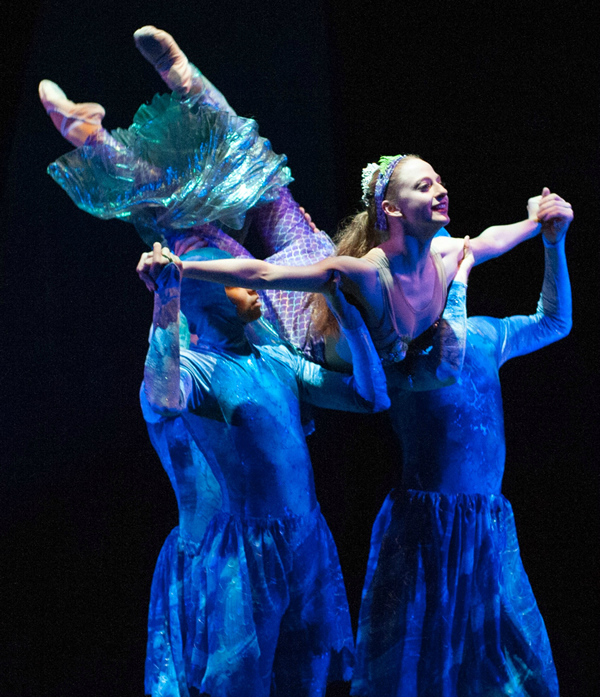
The cast of ‘The Little Mermaid.’ (Photo courtesy Imagination Stage)
Jesse Arnholz contributed to this interview.
a&e features
Queer highlights of the 2026 Critics Choice Awards: Aunt Gladys, that ‘Heated Rivalry’ shoutout and more
Amy Madigan’s win in the supporting actress category puts her in serious contention to win the Oscar for ‘Weapons’

From Chelsea Handler shouting out Heated Rivalry in her opening monologue to Amy Madigan proving that horror performances can (and should) be taken seriously, the Critics Choice Awards provided plenty of iconic moments for queer movie fans to celebrate on the long road to Oscar night.
Handler kicked off the ceremony by recapping the biggest moments in pop culture last year, from Wicked: For Good to Sinners. She also made room to joke about the surprise hit TV sensation on everyone’s minds: “Shoutout to Heated Rivalry. Everyone loves it! Gay men love it, women love it, straight men who say they aren’t gay but work out at Equinox love it!”
The back-to-back wins for Jacob Elordi in Frankenstein and Amy Madigan in Weapons are notable, given the horror bias that awards voters typically have. Aunt Gladys instantly became a pop culture phenomenon within the LGBTQ+ community when Zach Cregger’s hit horror comedy released in August, but the thought that Madigan could be a serious awards contender for such a fun, out-there performance seemed improbable to most months ago. Now, considering the sheer amount of critics’ attention she’s received over the past month, there’s no denying she’s in the running for the Oscar.
“I really wasn’t expecting all of this because I thought people would like the movie, and I thought people would dig Gladys, but you love Gladys! I mean, it’s crazy,” Madigan said during her acceptance speech. “I get [sent] makeup tutorials and paintings. I even got one weird thing about how she’s a sex icon also, which I didn’t go too deep into that one.”
Over on the TV side, Rhea Seehorn won in the incredibly competitive best actress in a drama series category for her acclaimed performance as Carol in Pluribus, beating out the likes of Emmy winner Britt Lower for Severance, Carrie Coon for The White Lotus, and Bella Ramsey for The Last of Us. Pluribus, which was created by Breaking Bad’s showrunner Vince Gilligan, has been celebrated by audiences for its rich exploration of queer trauma and conversion therapy.
Jean Smart was Hack’s only win of the night, as Hannah Einbinder couldn’t repeat her Emmy victory in the supporting actress in a comedy series category against Janelle James, who nabbed a trophy for Abbott Elementary. Hacks lost the best comedy series award to The Studio, as it did at the Emmys in September. And in the limited series category, Erin Doherty repeated her Emmy success in supporting actress, joining in yet another Adolescence awards sweep.
As Oscar fans speculate on what these Critics Choice wins mean for future ceremonies, we have next week’s Golden Globes ceremony to look forward to on Jan. 11.
a&e features
Looking back at the 10 biggest A&E stories of 2025
‘Wicked,’ Lady Gaga’s new era, ‘Sexy’ Bailey and more

Although 2025 was a year marked by countless attacks on trans rights and political setbacks, the year also saw brilliant queer artists continuing to create art. From Cannes and Sundance Award winners now vying for Oscar consideration to pop icons entering new stages of their careers, queer people persevered to tell their stories through different media.
With the state of the world so uncertain, perhaps there’s no more vital time to celebrate our wins, as seen through some of this year’s top pop culture moments. While there’s no collection of 10 stories that fully encompass “the most important” news, here are some events that got the gays going:
10. ‘Mysterious Gaze of the Flamingo’ wins big at Cannes

The Cannes Film Festival has become a crucial start for films hoping to make their way to the Oscars, and first-time director Diego Céspedes won the top Un Certain Regard prize for his intimate western “The Mysterious Gaze of the Flamingo.” The film is set in the ‘80s and is intended as an allegory for the AIDS epidemic. Seeing a film that unpacks vital queer history win one of the most coveted awards at Cannes has been a huge point of pride in the independent filmmaking community.
Since the film bowed at Cannes, it has been selected as Chile’s Oscar entry in the Best International Feature race. Speaking with The Blade during the film’s AFI Fest run in October, Céspedes said: At first, I was kind of scared to have this campaign position in the times that we’re living [in] here. But at the same time, I think the Oscars mean a huge platform — a huge platform for art and politics.”
9. ‘The Last of Us’ returns for an even gayer season 2
While the first season of The Last of Us gave us one of TV’s most heartbreaking queer love stories in the episode “Long, Long Time,” Season 2 doubled down on its commitment to queer storytelling with the blossoming relationship between Ellie (Bella Ramsey) and Dina (Isabela Merced). The show expanded on the pair’s relationship in the original video game, making it perhaps the central dynamic to the entire season. That unfortunately came with more homophobic backlash on the internet, but those who checked out all the episodes saw a tender relationship form amid the show’s post-apocalyptic, often violent backdrop. For their performance, Ramsey was once again nominated for an Emmy, but Merced deserved just as much awards attention.
8. ‘Emilia Pérez’ sparks controversy
Jacques Audiard’s genre-bending trans musical “Emilia Pérez” proved to be an awards season juggernaut this time last year, winning the Golden Globe for Best Musical/Comedy. But when the lead star Karla Sofia Gascón’s racist, sexist, and homophobic old tweets resurfaced, the film’s Oscar campaign became a tough sell, especially after Netflix had tried so hard to sell Emilia Pérez as the “progressive” film to vote for. Mind you, the film had already received significant backlash from LGBTQ+ audiences and the Mexican community for its stereotypical and reductive portrayals, but the Gascón controversy made what was originally just social media backlash impossible to ignore. The only person who seemed to come out of the whole debacle unscathed was Zoe Saldaña, who won the Oscar for Best Supporting Actress over Ariana Grande.
7. ‘Sorry, Baby’ establishes Eva Victor as major talent
Back in January at the Sundance Film Festival, Eva Victor (known by many for her brand of sketch comedy) premiered their directorial debut “Sorry, Baby” to rave reviews, even winning the Waldo Salt Screening Award. Victor shadowed Jane Schoenbrun on the set of “I Saw the TV Glow,” and seeing Victor come into their own and establish such a strong voice immediately made them one of independent cinema’s most exciting new voices. A memorable scene in the film sees the main character, Agnes (played by Victor), struggling to check a box for male or female, just one example of how naturally queerness is woven into the fabric of the story.
Most recently, Victor was nominated for a Golden Globe for her performance in the film, and she’s represented in a category alongside Jennifer Lawrence (“Die My Love”), Jessie Buckley (“Hamnet”), Julia Roberts (“After the Hunt”), Renate Reinsve (“Sentimental Value”) and Tessa Thompson (“Hedda”). The film also received four Independent Spirit Award nominations overall.
6. Paul Reubens comes out in posthumous doc

While Paul Reubens never publicly came out as gay before passing away in 2023, the two-part documentary “Pee-wee as Himself” premiered back in May on HBO Max, giving the legendary comedian a chance to posthumously open up to the world. Directed by Matt Wolf, the documentary explores how Reubens found his alter ego Pee-Wee Herman and why he kept his private life private.
The documentary won an Emmy in the Outstanding Documentary or Nonfiction Special category and remains one of the most critically acclaimed titles of the year with a 100% Rotten Tomatoes score. Also worth noting, the National Geographic documentary Sally told the posthumous coming out story of Sally Ride through the help of her long-time partner, Tam O’Shaughnessy.
5. Lady Gaga releases ‘Mayhem’
Lady Gaga entered a new phase of her musical career with the release of Mayhem, her seventh album to date. From the frenzy-inducing pop hit Abracadabra to the memorable Bruno Mars duet featured on “Die With a Smile,” seeing Gaga return to her roots and make an album for the most die-hard of fans was especially rewarding after the underwhelming film releases of “House of Gucci” and “Joker: Folie à Deux.” Gaga has been touring with The Mayhem Ball since July, her first arena tour since 2018. She even extended her tour into 2026 with more North American dates, so the party isn’t stopping anytime soon. And Gaga is even set to make an appearance next May in “The Devil Wears Prada 2.”
4. Cynthia Erivo, Ariana Grande perform at the Oscars

While “Wicked: For Good” didn’t quite reach the heights of the first film, we will forever have Cynthia Erivo and Ariana Grande’s breathtaking live performance that opened the 97th Academy Awards. The pair sang a rendition of “Over the Rainbow,” “Home,” and “Defying Gravity,” paying proper homage to the original 1939 “Wizard of Oz.” Even non-Wicked fans can’t deny how magical and brilliantly staged this performance was. With both Erivo and Grande up for acting Oscars last year, they’re hoping to repeat success and make history with consecutive nominations. Either way, let’s hope there’s another live performance in the making, especially with two new original songs (The Girl in the Bubble and No Place Like Home) in the mix.
3. Indya Moore speaks out against Ryan Murphy
Indya Moore has consistently used social media as a platform for activism, and in September, posted a 30-minute Instagram live speaking out against “Pose” co-creator Ryan Murphy. Moore claimed that Murphy wasn’t being a true activist for trans people. “Ryan Murphy, we need you to do more. You need to address the racism, the violence, and the targeting of people on your productions, Ryan Murphy. You do need to make sure trans people are paid equally. Yes, Janet did the right thing,” Moore said. Murphy was also back in the headlines this year for the critically panned “All’s Fair” and the controversial “Monster: The Ed Gein Story” starring Laurie Metcalf and Charlie Hunnam.
2. Cole Escola wins Tony for Best Leading Actor
Few pop culture moments this year brought us together more than Cole Escola winning a Tony award for “Oh, Mary!” the Broadway show they created, wrote and starred in (we love a triple threat!) Escola made history by becoming the first nonbinary person to win a Tony in the leading actor category, and seeing them excitedly rush to the stage wearing a Bernadette Peters-inspired gown instantly became a viral social media moment.
The cherry on top of Escola’s major moment is the recent news that they are writing a Miss Piggy movie with Jennifer Lawrence and Emma Stone producing — news that also broke the internet for the better. We cannot wait!
1. Jonathan Bailey makes gay history as ‘Sexiest Man Alive’

The same year as his on-screen roles in blockbusters “Jurassic World Rebirth” and “Wicked: For Good,” Jonathan Bailey made history as the first openly gay man to be named People magazine’s “Sexiest Man Alive.” The fact that it took 40 years for an openly gay man to earn the title is a signifier of how far we still have to go with queer representation, and seeing Bailey celebrated is just one small step in the right direction.
“There’s so many people that want to do brilliant stuff who feel like they can’t,” he told PEOPLE, “and I know the LGBT sector is under immense threat at the moment. So it’s been amazing to meet people who have the expertise and see potential that I could have only dreamed of.” In 2024, Bailey founded the charity titled The Shameless Fund, which raises money for LGBTQ+ organizations.
a&e features
Your guide to D.C.’s queer New Year’s Eve parties
Ring in 2026 with drag, leather, Champagne, and more

With Christmas in the rear view mirror, we can turn our attention to ringing in a much-anticipated New Year with a slew of local LGBTQ parties. Here’s what’s on tap.
Pitchers
This spacious Adams Morgan bar is hosting the “Pitchers’ Perfect New Year’s Eve.” There will be a midnight Champagne toast, the ball drop on the big screens, and no cover, all night long. The bar doesn’t close until 4 a.m., and the kitchen will be open late (though not until close). All five floors will be open for the party, and party favors are promised.
Trade
D.C.’s hottest bar/club combo is leaning into the Shark motif with its NYE party, “Feeding Frenzy.” The party is a “glitterati-infused Naughty-cal New Year’s Even in the Shark Tank, where the boats are churning and the sharks are circling.” Trade also boasts no cover charge, with doors opening at 5 p.m. and the aforementioned Shark Tank opening at 9 p.m.. Four DJs will be spread across the two spaces; midnight hostess is played by Vagenesis and the two sea sirens sensuously calling are Anathema and Justin Williams.
Number Nine
While Trade will have two DJs as part of one party, Number Nine will host two separate parties, one on each floor. The first floor is classic Number Nine, a more casual-style event with the countdown on TVs and a Champagne midnight toast. There will be no cover and doors open at 5 p.m. Upstairs will be hosted by Capital Sapphics for its second annual NYE gathering. Tickets (about $50) include a midnight Champagne toast, curated drink menu, sapphic DJ set by Rijak, and tarot readings by Yooji.
Crush
Crush will kick off NYE with a free drag bingo at 8 p.m. for the early birds. Post-bingo, there will be a cover for the rest of the evening, featuring two DJs. The cover ($20 limited pre-sale that includes line skip until 11 p.m.; $25 at the door after 9 p.m.) includes one free N/A or Crush, a Champagne toast, and party favors (“the legal kind”). More details on Eventbrite.
Bunker
This subterranean lair is hosting a NYE party entitled “Frosted & Fur: Aspen After Dark New Year’s Eve Celebration.” Arriety from Rupaul Season 15 is set to host, with International DJ Alex Lo. Doors open at 9 p.m. and close at 3 p.m.; there is a midnight Champagne toast. Cover is $25, plus an optional $99 all-you-can-drink package.
District Eagle
This leather-focused bar is hosting “Bulge” for its NYE party. Each District Eagle floor will have its own music and vibe. Doors run from 7 p.m.-3 a.m. and cover is $15. There will be a Champagne toast at midnight, as well as drink specials during the event.
Kiki, Shakiki
Kiki and its new sister bar program Shakiki (in the old Shakers space) will have the same type of party on New Year’s Eve. Both bars open their doors at 5 p.m. and stay open until closing time. Both will offer a Champagne toast at midnight. At Kiki, DJ Vodkatrina will play; at Shakiki, it’ll be DJ Alex Love. Kiki keeps the party going on New Year’s Day, opening at 2 p.m., to celebrate Kiki’s fourth anniversary. There will be a drag show at 6 p.m. and an early 2000s dance party 4-8 p.m.
Spark
This bar and its new menu of alcoholic and twin N/A drinks will host a NYE party with music by DJ Emerald Fox. Given this menu, there will be a complimentary toast at midnight, guests can choose either sparkling wine with or without alcohol. No cover, but Spark is also offering optional wristbands at the door for $35 open bar 11 p.m.-1 a.m. (mid-shelf liquor & all NA drinks).
-

 Photos4 days ago
Photos4 days agoThe year in photos
-

 Sponsored3 days ago
Sponsored3 days agoSafer Ways to Pay for Online Performances and Queer Events
-

 District of Columbia2 days ago
District of Columbia2 days agoTwo pioneering gay journalists to speak at Thursday event
-

 a&e features2 days ago
a&e features2 days agoQueer highlights of the 2026 Critics Choice Awards: Aunt Gladys, that ‘Heated Rivalry’ shoutout and more

